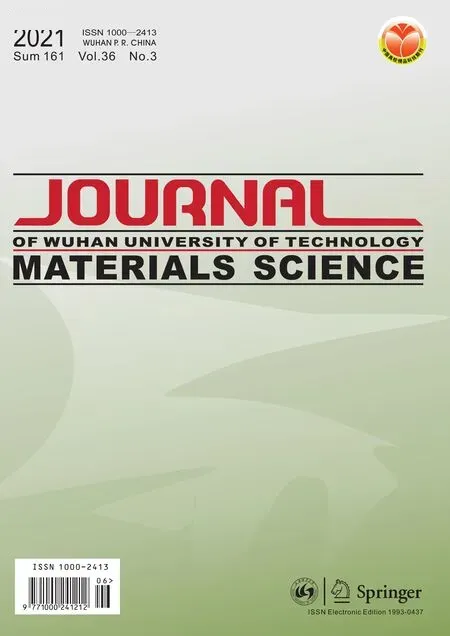Effects of Magnetization on Thermoelectric Transport Properties of CoSb3 Material
2021-06-14ZHUJianglongTONGXinNIUShuoLIUZhiyuanXUDong
ZHU Jianglong, TONG Xin, NIU Shuo, LIU Zhiyuan*, XU Dong*
(1. Key Laboratory of Green Fabrication and Surface Technology of Advanced Metal Materials, Ministry of Education, Anhui University of Technology, Maanshan 243002, China; 2. School of Materials Science and Engineering, Anhui University of Technology, Maanshan 243002,China)
Abstract: The effects of magnetization on the phase composition, microstructure and thermoelectric transport properties of CoSb3 were studied systematically. The magnetic properties of CoSb3 material were also measured at room temperature in order to confirm its magnetic category. The results of XRD and FESEM analysis indicated that the phase composition and microstructure of the CoSb3 were not affected by magnetization. The results of thermoelectric transport measurement showed that the electrical and thermal transport properties of materials were also not affected by magnetization. These results were mainly attributed to the diamagnetism of the CoSb3 material, which were consistent with the results of the magnetic properties measurement. This study is expected to provide a special research perspective for studying the effects of the external conditions on the structure and properties of thermoelectric materials.
Key words: CoSb3 materials; magnetization; thermoelectric properties; thermoelectric materials
1 Introduction
Thermoelectric materials can directly convert thermal energy to electrical energy, and are expected to be widely used in the fields of power generation and refrigeration[1,2]. The performance of thermoelectric materials is characterized by the dimensionless figure of meritZT(ZT=σα2T/κ), which is mainly determined by the electrical conductivity (σ), Seebeck coefficient (α), thermal conductivity (κ).Tis the absolute temperature, andσα2is the power factor.According to the applicable temperature of thermoelectric materials, it can be divided into low-, medium-,and high-temperature thermoelectric materials. N-type CoSb3-based materials[3-7]and p-type Fe4Sb12-based materials[8-11]are recognized as the most promising thermoelectric material in the mid-temperature range due to their excellent electrical transport properties.Thermoelectric transport properties of CoSb3material have been significantly improved by some optimization methods, such as forming solid solution alloy[12,13],introducing foreign atoms into the Sb12icosahedron void to form the filled CoSb3[14-16], and also introducing some special structures and nanoparticles[17-20].However, the effects of magnetization on thermoelectric transport properties of CoSb3material are rarely studied. In general, the effects of magnetization on the properties of magnetic materials are the main research focus because the domains of magnetic material can be randomly controlled by external magnetic field[21-24].However, the effects of magnetization on the properties of nonmagnetic materials are less studied. Therefore,it is a good research point to explore the effects of magnetization on transport properties of CoSb3thermoelectric material.
In this study, CoSb3material was successfully prepared by the traditional melting-annealing combined with SPS sintering process, which was then magnetized along three different directions. The phase composition and microstructure of magnetized samples were systematically investigated. The thermoelectric properties of magnetized samples were measured in the temperature range from 300 to 800 K. The magnetic properties of the samples were also measured at room temperature in order to confirm the magnetic category of CoSb3material. This work is expected to provide a special research perspective for studying the effects of the external environment on the structure and properties of thermoelectric materials.

Fig.1 The schematic diagram of the sample cutting, magnetization and measurement
2 Experimental
2.1 Sample synthesis and magnetization
High purity metals Co and Sb were weighed according to nominal compositions CoSb3. The mixtures of these high purity elements were sealed in quartz tube under a vacuum of less than 0.1 MPa and transferred into a programmable furnace, and then heated up to 953 K for 36 h. The obtained products were ground into fine powders. The as-prepared powder sample CoSb3was sintered into bulk pellets with a diameter of 15 mm by the SPS method at a sintering temperature of 948 K under a pressure of 50 MPa in a graphite die. The SPS bulk pellets withФ15 mm × 4 mm were sliced into circular sheets withФ10 mm×1.9 mm and bars with 10 mm×4.5 mm×3.5 mm. The circular sheets and bars samples were magnetized along three different directions by a magnet with a magnetic induction intensity (H) of about 0.2 T. The magnetized CoSb3samples along a, b and c three different directions were labeled as MS_a CoSb3, MS_b CoSb3and MS_c CoSb3, while the unmagnetized CoSb3sample was labeled as US CoSb3. The schematic diagram of the magnetization of samples is shown in Fig.1.
2.2 Characterization and measurement
X-ray diffraction (XRD) analysis (PANalyticalX’Pert PRO X-ray diffraction) was used to examine the purity of the samples before and after magnetization. The morphology and microstructure were investigated by secondary electron image (SEI) of the field emission scanning electron microscopy (FESEM,Hitachi S-4800). Theσandαwere measured in the temperature range of 300-800 K with the standard four-probe method (Sinkuriko, ZEM-3) in an Ar atmosphere. Theκwas calculated by using the equationκ=λρ0Cp, whereCpis the specific heat capacity,ρ0is the bulk density, andλis the thermal diffusivity coefficient.λwas measured in the temperature range of 300-800 K with a laser flash technique (Netzsch, LFA-427) in a flowing Ar atmosphere.Cpwas measured by using a TA Q20 differential scanning calorimeter.ρ0was obtained by the Archimedes method (Sartorius, YDK01). TheκEwas calculated by the Wiedemann-Franz law asκE=LσT(Lis Lorenz number andL=2.0×10-8V2·K-2)[25].κLwas obtained by using the equationκL=κ-κE. Uncertainties inσandκare ± 5%-7%. Uncertainty in α is ± 5%.Details were also described in Ref.[15]. The room-temperature magnetic properties measurements of sample was performed on a physical property measuring system 9-model (PPMS-9) (Quantum Design INC., USA)with a maximum applied field of 15 000 Oe and the samples were measured under a vacuum of less than 9 torr.
3 Results and discussion
Fig.2 shows the XRD patterns of the CoSb3samples before and after magnetization along three different directions. It can be seen that the diffraction peaks of all samples can be indexed from the standard JCPDS file 89-4871 of CoSb3. All samples were composed of single-phase CoSb3, suggesting that CoSb3sample can remain good chemical stability after magnetization along three different directions. This also shows that magnetization does not cause the change of phase composition of the CoSb3sample.
FESEM photographs of the CoSb3sample before and after magnetization along three different directions are shown in Fig.3. It can be observed that the grain boundaries and interfaces are straight and very clean without any impurity particles for all the samples. The intergranular fracture is dominant in all the samples.The grain size of all samples is uniform with about 2-8 μm. The obvious orientation change of particles was not observed, which was also found in the above XRD analysis. These results also show that magnetization has no effect on the microstructure of the CoSb3sample.
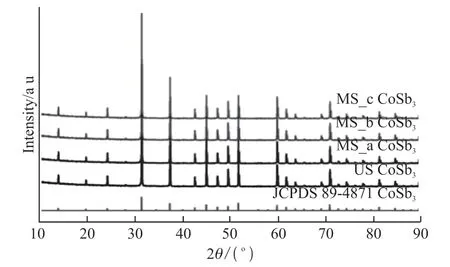
Fig.2 XRD patterns of the CoSb3 sample before and after magnetization along a, b and c three different directions
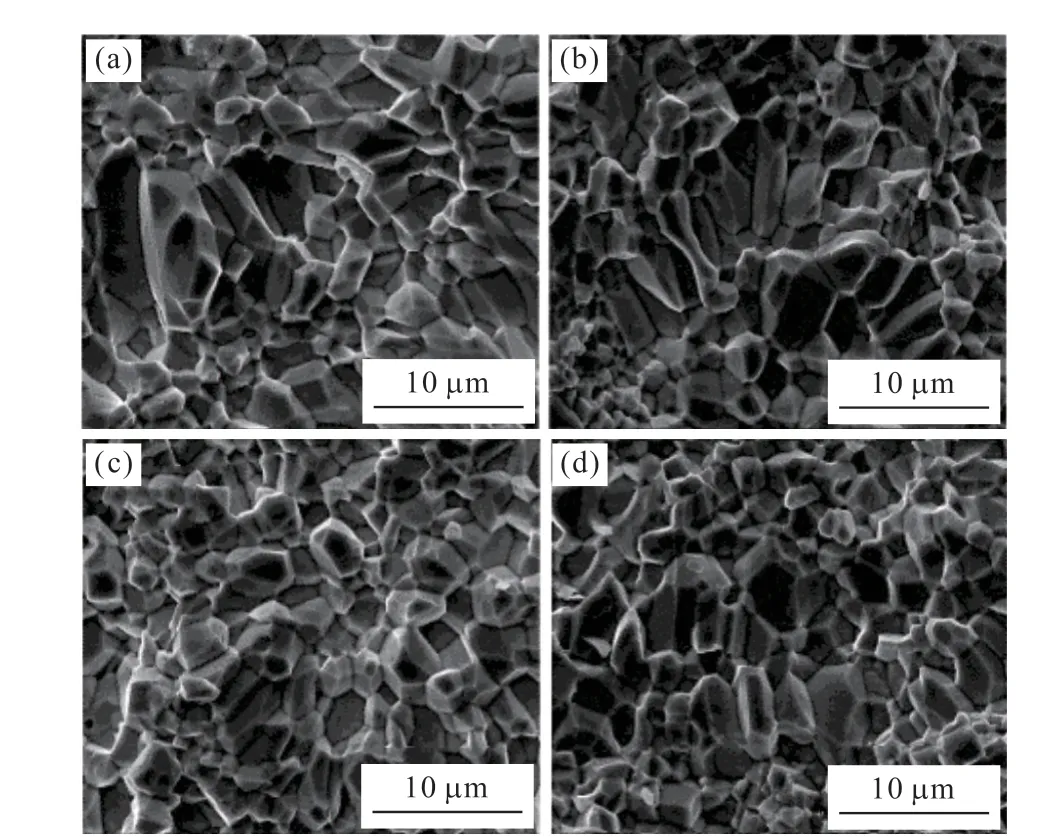
Fig.3 FESEM photographs of the CoSb3 sample before and after magnetization along three different directions: (a) US CoSb3 sample; (b) MS_a CoSb3 sample; (c) MS_b CoSb3 sample; and (d) MS_c CoSb3 sample
Fig.4 displays the temperature dependences of electrical transport properties of CoSb3sample before and after magnetization along the a, b and c directions in the range 300-800 K. It can be seen that theσof all samples increased gradually with increasing temperature in the range of 300-800 K (Fig.4 (a)), showing a semiconducting behavior[13]. Theαof all samples is negative at low temperatures (300-450 K), displaying n-type conduction behavior (Fig.4(b)). At high temperatures, it changes to become positive, showing p-type conduction behavior. These evolutions of theαwere also observed in some other reports[14,26-28]. The reason of these evolutions can be reasonably explained with that the mobility of minority carriers is much larger than the electron mobility at high temperatures due to an onset of intrinsic conduction[29]. Intrinsic CoSb3shows p-type conductivity, which has been reported in literatures[30,31]. As shown in Fig.4, after magnetization along the a, b and c directions, theσandαof CoSb3sample remains almost unchanged in the range 300-800 K. Therefore, the power factorα2σof CoSb3sample also remains almost unchanged after magnetization,as shown in the inset of Fig.4(b). This suggests that the electrical transport properties of the CoSb3sample were not affected by magnetization.
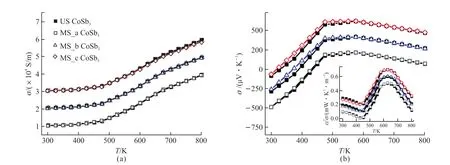
Fig.4 Temperature dependence of (a) electrical conductivity σ and (b) Seebeck coefficient α of the CoSb3 sample before and after magnetization along a, b and c three different directions (The inset in (b) shows the temperature dependence of the power factor α2σ. The curves were shifted upwards in order to clearly observe the evolutions of electrical transport properties induced by the magnetization)
Fig.5(a) shows the temperature dependence of thermal conductivityκfor the CoSb3sample before and after magnetization along the a, b and c directions in the range 300-800 K. Theκof all samples decreased with increasing temperature in the range of 300-675 K because of the strong scattering of phonon by lattice,and then slightly increased above 675 K due to the bipolar thermal diffusion. TheκandκLof CoSb3sample also remains almost unchanged in the range 300-800 K after magnetization along three directions. This indicates that the thermal transport properties of the CoSb3sample were not also affected by magnetization. TheZTvalues of all samples were calculated with theα,σandκvalues above. Fig.5(b) showsZTvalues of the magnetized CoSb3sample along the a, b and c directions in the range 300-800 K. It can be seen that theZTvalue of the sample does not change before and after magnetization, indicating that the thermoelectric properties of CoSb3sample will not be affected by magnetization.

Fig.5 Temperature dependence of (a) thermal conductivity κ and (b) ZT figure of merit of the CoSb3 sample before and after magnetization along a, b and c three different directions (The inset in (a) shows temperature dependence of the lattice thermal conductivity κL. The curves were shifted upwards in order to clearly observe the evolutions of thermal transport properties and ZT values induced by the magnetization)
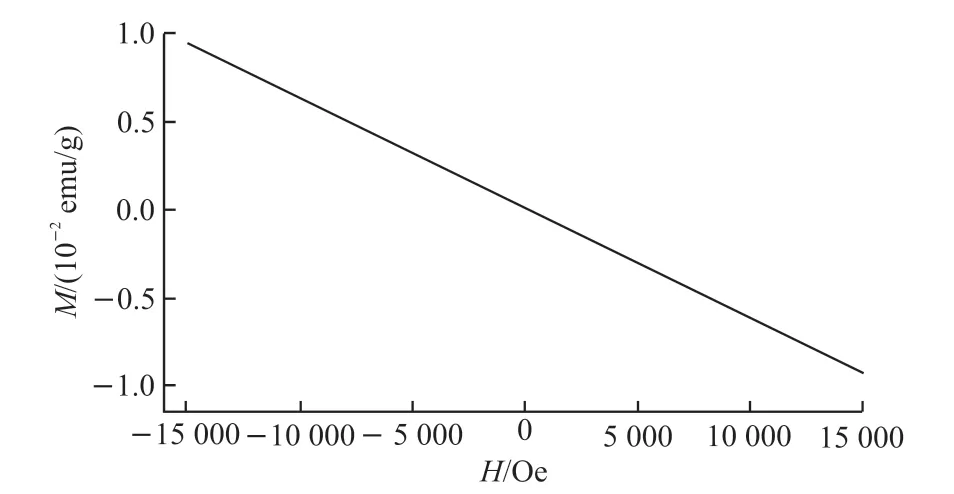
Fig.6 Magnetization versus magnetic field of CoSb3 sample
Based on the above analysis results, the phase composition, microstructure and thermoelectric properties of the magnetized CoSb3sample were no affected by the magnetization and magnetization direction. This may be related to the diamagnetism of the CoSb3sample because of the low spin state (S=0) of A11ground state of Co3+ion based on the electronic bonding model of CoSb3[32,33]. To confirm that the CoSb3sample is indeed a diamagnetic material, the dependence curve (M vsHcurve) of magnetization on magnetic field of sample at room temperature was measured by the PPMS-9 system with a maximum applied field of 15 000 Oe.Fig.6 shows the magnetizationversusmagnetic field of CoSb3sample at room temperature. It can be seen that no hysteresis loop was observed in theMvs Hcurve. The dependence of magnetization on magnetic field of CoSb3sample at room temperature is only a straight line passing through the origin and second,fourth quadrants, which shows the characteristics of the diamagnetic materials. This further confirmed that the CoSb3sample is a diamagnetic material. Therefore, the main reason why the phase composition, microstructure and thermoelectric transport properties were not affected by magnetization is that the CoSb3sample has a characteristic of diamagnetism.
4 Conclusions
CoSb3material was successfully prepared by the traditional melting-annealing combined with SPS sintering process. CoSb3sample was magnetized along three different directions. The phase composition and microstructure of magnetized samples were systematically investigated. The thermoelectric properties were also measured in the temperature range from 300 to 800 K. In order to confirm the magnetic category of CoSb3material, the magnetic properties were measured with PPMS-9 at room temperature. The phase composition and microstructure of the CoSb3were not affected by magnetization based on the results of XRD and FESEM analysis. The electrical and thermal transport properties of CoSb3were also not affected by magnetization according to the results of thermoelectric transport measurement. These results may be mainly attributed to the diamagnetism of the CoSb3material,which is consistent with the results of the magnetic properties measurement. The analysis result ofM vs Hcurve of sample confirmed that the CoSb3is indeed a diamagnetic material. This work is expected to provide a special research perspective for studying the effects of the external environment on the structure and properties of thermoelectric materials.
杂志排行
Journal of Wuhan University of Technology(Materials Science Edition)的其它文章
- In Vitro Angiogenic Behavior of HUVECs on Biomimetic SF/SA Composite Scaffolds
- Synthesis and Performance Characterization of a Low Adsorption Clay-resistant Polycarboxylate Superplasticizer
- Strength and Microstructural Analysis of Geopolymer Prepared with Recycled Geopolymer Powder
- Preparation of Phlogopite-based Geopolymer and Its Surface Nonpolar Modification
- Properties and Structure of PEO Treated Aluminum Alloy
- Effects of Strain Rate on the Mechanic Performance of Lattice Materials
